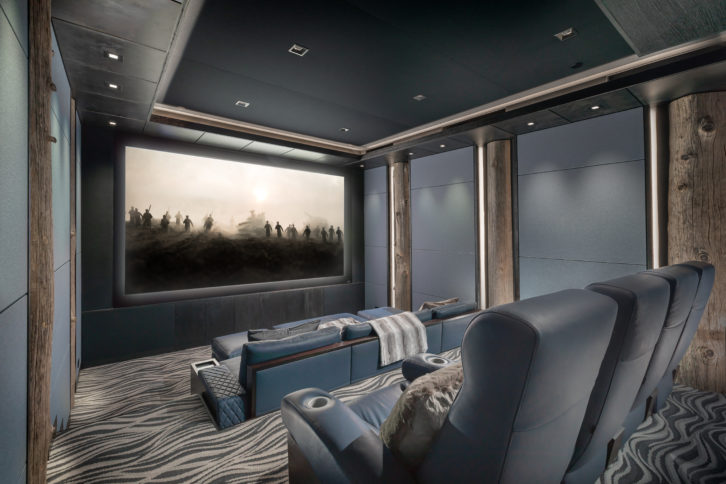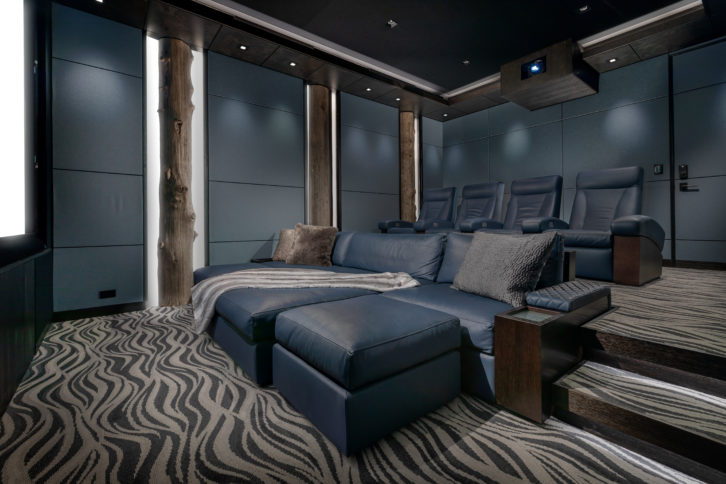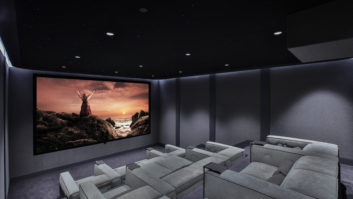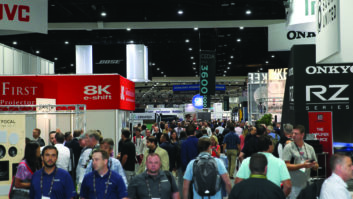Two ideas that are currently pervading the home theater industry share certain dubious qualities. One, the idea that “value engineering” is a good thing, could be considered at best an oxymoron. We have only ourselves to blame as we have conditioned our clientele to demand discounts then backpedal to scope or performance reduction to maintain a survivable bottom line. The other idea, “home theater is dead,” is just as inaccurate as the Mark Twain misquote “the rumor of my demise was greatly exaggerated” (he actually said, “the report of my death was an exaggeration”). Either way it is inaccurate.
Now the stars may have aligned for increased interest in private cinema. Most importantly, though, is leveraging that interest to establish quality and performance standards of excellence that are compelling enough to support a renaissance of residential cinema appreciation.

What happened? As is often the case, many seemingly unrelated events combined to create the current opportunity. Greater image resolution and quality, immersive audio formats, improved audio performance, and convenience and greater accessibility to content led the charge on the technology side. Film and media competed as streaming services created studios that attracted A-list talent and provided opportunity for emerging artists. Aside from a profusion of new choices, the added buzz and activity resulted in a rising tide scenario and drew attention to film, media, technology, and cinema, both public and private.
Enter 2020. Clearly the pandemic impacted all of us and nothing would be better than if we could rewrite the last 18 months or so. Unfortunate circumstances, however, have a way of bringing about new opportunities. Successful industries discover new opportunities in disruption, and the savvy leaders of affected industries guide their companies and clientele to benefit from change.
Cinema, both private and commercial, stands at such a crossroads. For us in the private cinema arena, the chance to grasp the increased public awareness and lead our clientele to a better experience is both an opportunity and a challenge. Things are going to be different, and how that transpires is up to us. Movies on phones, personal devices, and soundbars represents one direction. A better outcome is sharing with an increasingly interested public the benefits of quality cinematic experiences in the home. We have the opportunity to lead our clientele and our industry to new heights of satisfaction and enjoyment.
What benefits should our clientele expect? Few would argue that private cinemas will entirely replace public movie theaters. We will still go out to the movies — the scale, the sense of occasion, the crowds, and the whole experience is different from what is to be had at home. Indeed, at home it can be superior! Performance quality can be near-precise or even precisely what the artists’ experience when screening the film before public release. We have been designing and delivering private cinemas at this level for some time.
Aesthetically, the experience can be far superior to any public cinema. Creativity has no limits and stunning triumphs of design have been created that have the added benefit of enhancing a room’s performance. As for comfort, convenience, and value, there is no comparison. A fine private cinema is an amenity where families and friends gather and experience a beloved form of entertainment at a remarkable level of enjoyment. But, buyer beware, there is much offered that is unlike it! Just like in commercial cinemas, there are good and bad examples. We’ve all experienced the cineplex auditorium with poor seating, bad sound, and bad company. Fortunately, we can avoid these same mistakes in our homes! The following summary outlines how to do just that.
Also by Sam Cavitt: Planning in the Pursuit of Perfection
Building a High-Quality Home Cinema
A quality private cinema includes essential attributes — qualities every consumer should be aware of and demand that every professional should be diligent to provide. These attributes are:
Environmental
- Distraction free
- Acoustically balanced
- Aesthetically pleasing
- Ergonomically correct
- Healthful
Functional
- Performance engineered
- Properly equipped
- Performance verified
- User friendly
Experiential
- Suspension of disbelief
- Compelling
At first glance, these may seem obvious, but to realize these essential attributes requires a commitment to excellence by the entire private cinema team, including the client.
While all of the essential attributes are important, none are foremost. Delivering a great private cinema is a holistic design and engineering process that demands knowledge, skill, and careful attention to detail to get right. For this reason, early involvement by the cinema design and engineering team is vital. Sight, sound, and comfort are all subject to the laws of physics. Early planning can assure these considerations all play well together.
Take, for instance, the environmental items noted previously. Creating a distraction-free environment means addressing noise intrusion, ventilation, light control, and even positioning of people and aesthetic elements. It is quite possible to engineer a perfect noise-free environment that would fail to support balanced interior acoustics, be prohibitive to efficient, quiet ventilation, and result in an uncomfortable and unpleasant experience. Such a mal-engineered room cannot be improved with electronics at any cost, and will never deliver a satisfying experience.

The pathway to success is a process that assures realization of these essential attributes in an integrated cinema design. We on the professional side, whether integrator, designer, or engineer, need to adopt this as our mandate. On the client side, it is the only reasonable demand. This process is not unlike that followed by architects, which should not surprise us since a private cinema is the most technically demanding room within the home. This process includes the following steps/phases: Discovery, Schematic Design, Design Development, Documentation, Construction Administration, and Commissioning.
Discovery — This involves client interviews to establish real objectives, often requiring multiple meetings to allow ideas to develop and awareness of feature benefits to grow. Failure to properly execute a discovery may result in under-performance or over-engineering. Neither is appropriate, but under-performance is the more serious. I find using these meetings to help our clients “discover” a greater appreciation for what their new cinema can offer to be powerfully beneficial. Our clients agree.
Schematic Design — This is the program and overall space planning. Engineering as required to confirm feasibility, reveal issues, and provide solutions before they become problems. Coordination with other trades such as mechanical, electrical, and structural is done here. Generally, this process provides development of the conceptual design to a point sufficient for the client to approve. Budgets should only be considered as ranges so as to prevent arbitrary limitations to the development of the cinema. The feedback we have received from our clientele is that this is where the cinema project becomes less of a dream and more of a reality. Enthusiasm for what is to come tends to open many doors to better results.
Design Development — Private cinemas are technical, performance-oriented projects, much like a fine automobile or aircraft. Accordingly, the design development phase should start with engineering to make sure the room and systems will perform. These engineering studies will inform the design of the room as well as the specification of the systems required to drive it. This is a departure from what has commonly been done, which is to specify a system and then consider the room. This old way of doing things is akin to specifying an aircraft engine before knowing the size of the plane and hoping it will fly.
The second part of design development is creation or adaptation of the interior concept. This, too, represents a change from what is often seen. Although one of the rules of good design is “form shall always follow function,” it is not uncommon that aesthetic design and even system specification and seating arrangements have been committed to prior to an engineered functional design. When the functional design is completed first, creative interior designers have a template to follow and can work wonders. Following the collaborative process of schematic design to functional design to interior concept will always deliver better results, and allows all members of the cinema design team to do their best work. This phase culminates with a rendering that the client can approve with confidence since it is based on a certainty of feasibility. It is at this point that real project budgets can be provided as systems, construction methodology, and interior finishes will have been selected.
Documentation — Production of detailed documentation is a vital step in minimizing assumptions and miscommunications in the completion of a private cinema. This all-inclusive design document should include construction details and drawings for the functional shell, interior construction, lighting, mechanical, acoustics, systems, and schedules, and is the final word on how the cinema will be completed. It is not uncommon to produce a 40-plus-page set of architectural D Sheets in order to accurately communicate all that needs to be considered. This should be no surprise for the most technically detailed and demanding room in the entire home!
Construction Administration — The term Construction Administration entails support, inspections, measurements, and any other direction required to assure the project is completed successfully as designed. Successful private cinema projects are highly orchestrated efforts that require many participants: builders, subcontractors — including electrical, mechanical, and other specialties — integrators, designers, and more. Every inspection and verification measurement should be documented, and the shortfalls addressed and diligently communicated to the client and project team for transparency and effective collaboration. This assures our clientele that their theater is being built as designed and will perform as engineered.
Commissioning — Culminating in the formal delivery of a private cinema, the commissioning process includes a thorough “white glove” inspection of every element. From fit and finish of the interior treatments, verification of the noise levels and performance of isolation doors, enclosures and other sound mitigation, calibration and fine tuning of video and audio systems, confirmation of programming efficacy, and user interface, lighting scenes, and operation. Finally culminating in a formal delivery where, like a cinema sommelier, we demonstrate and elucidate the performance characteristics for our client, thus enhancing their awareness of how to appreciate and fully enjoy their private cinema!
The Theater as Prized Possession
When starting to write this article the topic was “how to take your home theaters to the next level.” As the article developed, it occurred to me that designers of other luxury amenities aren’t in a position to need this justification. Ironically, fortunes may, in fact, reverse. While the pandemic has seemed to quash the value of some luxury items, such as cars (yachts, not so much, what a way to socially distance — especially if your yacht includes a cinema!), private cinema is in a position to become higher valued and in the spotlight more than ever before.
Instead of thinking about taking our home theaters to the next level, what about establishing private cinema’s rightful place in the hierarchy of desirable amenities and prized possessions? Few items can compare in the arena of shared pleasure to what a private cinema can provide. As an industry, let’s make sure we are serving our clientele well, focusing on excellence, and eschewing compromise. As consumers, please demand this of us. Together, we can make private cinema the experience nonpareil!
Also by Sam Cavitt: The Who, What, When, Where, Why, and How of Private Theater
Sam Cavitt is the founder and CEO of Paradise Theater. Sam and his team have created nearly a thousand of the world’s finest private cinemas. Based on the core values of Experience Nonpareil and Excellence Always, Paradise Theater has developed and employs a definitive process that always produces excellent results. Paradise Theater works closely with the finest integrators, architects, designers, builders, and, most importantly its clientele to deliver the perfect solution, every time. Sam is also spearheading Cinema Connoisseur, an initiative to create a community of enthusiasts, cinema connoisseurs, both professional and public, to embrace and enhance the world of private cinema and film.





